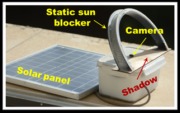Yoav Y. Schechner: Research
Clouds in the Cloud

Light-field imaging can be scaled up to a very large area, to map the Earth's atmosphere in 3D. We develop sky integral-imaging, by a wide, scalable network of wide-angle cameras looking upwards, which upload their data to the cloud. This new type of imaging-system poses new computational vision and photography problems, some of which generalize prior monocular tasks. These include radiometric self-calibration across a network, overcoming flare by a network, and background estimation. On the other hand, network redundancy offers solutions to these problems, which we derive. Based on such solutions, the light-field network enables new ways to measure nature. To demonstrate this, we have built the small Sky-Technion Array of Sensors (STARS). This led to experiments showing 3D recovery of clouds, in high spatio-temporal resolution. It is achieved by space carving of the volumetric distribution of semi-transparent clouds. Such sensing can complement satellite imagery, be useful to meteorology, make aerosol tomography realizable, and give new, powerful tools to atmospheric and avian wildlife scientists.
Publications
- Dmitry Veikherman, Amit Aides, Yoav Y. Schechner and Aviad Levis “Clouds in The Cloud,” Proc. ACCV (2014).
Data
Data extracted by the Sky-Technion Array of Sensors (STARS), is available for non-commercial use of the scientific community. You can use it if you clearly acknowledge the source by citing "Clouds in The Cloud" detailed above in your work. Please contact the authors to get access to the data (86 GB).Related Research
 The small Sky-Technion Array of Sensors (STARS) in one experiment
The small Sky-Technion Array of Sensors (STARS) in one experiment  Flare avoidance withour moving parts: static shader for year-round sun trajectories.
The network as a whole has no blind-spot
Flare avoidance withour moving parts: static shader for year-round sun trajectories.
The network as a whole has no blind-spot  3D reconstruction of cumulus
3D reconstruction of cumulus  A camera unit (node) of the STARS network
A camera unit (node) of the STARS network  Background estimation relaying on network redundancy and cloud-field stationarity
Background estimation relaying on network redundancy and cloud-field stationarity  3D reconstruction of altocumulus
3D reconstruction of altocumulus Radiometric self-calibration within a network
Radiometric self-calibration within a network  Auto-tracking extra-terrestrial objects for precise geometric calibration of STARS
Auto-tracking extra-terrestrial objects for precise geometric calibration of STARS

